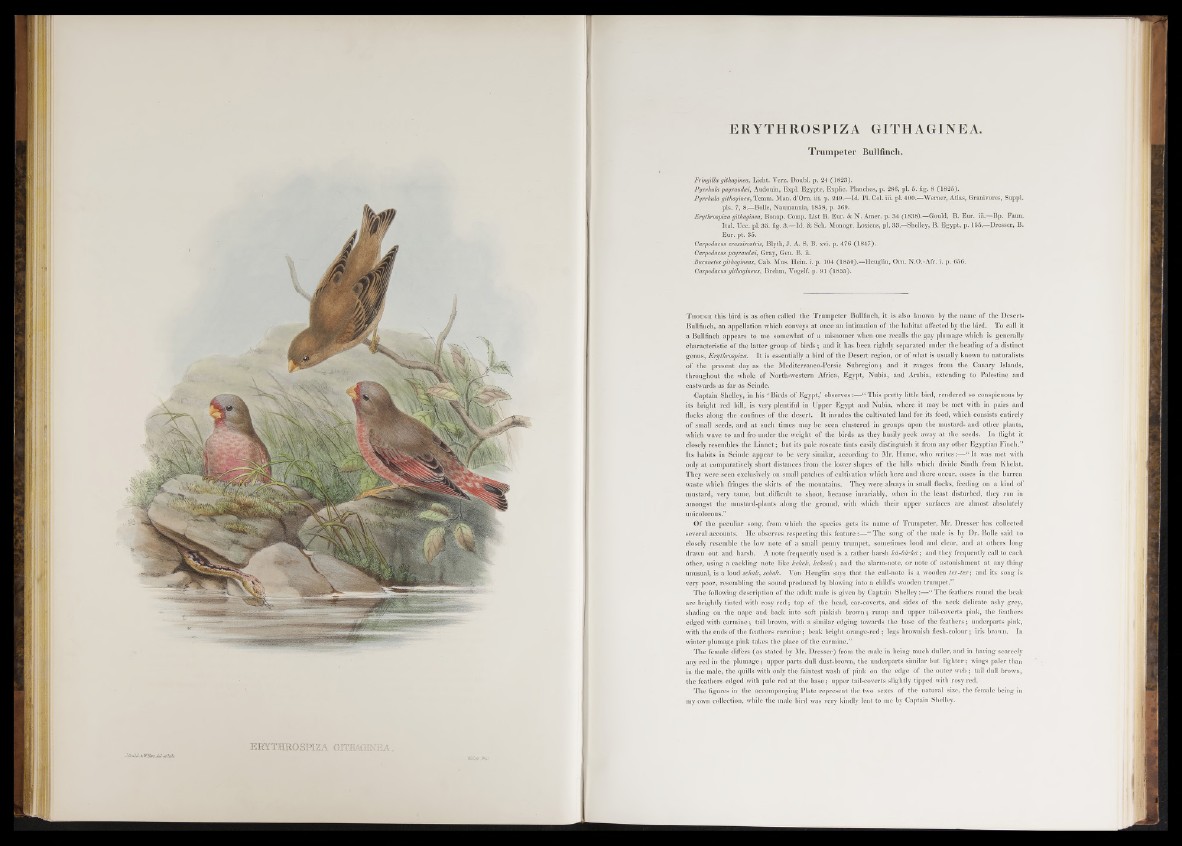
EEYTHRQ SPIZA GITHAGINEA.
J-tmüS’ttVÏÏ&BtMiet'luJK
ERYTHRO S PIZ A GITHAGINEA.
Trumpeter Bullfinch.
Fringilla githaginea, Licht. Verz. Doubl, p. 24 (1823).
Pyrrhula payraudcei, Audouin, Expl. Egypte, Explic. Planches, p. 286, pi. 5. fig. 8 (1825).
Pyrrhula githaginea, Temm. Man. d’Orn. iii. p. 249.—Id. PI. Col. iii. pi. 400.—"Werner, Atlas, Granivores, Suppl.
pis. 7, 8.—Bolle, Naumannia, 1858, p. 369.
Erythrospiza githaginea, Bonap. Comp. L ist B. E ur. & N . Amer. p. 34 (1838).—Gould, B. Eur. iii.—Bp. Faun.
Ita l. Ucc. pi. 35. fig. 3.—Id . & Sch. Monogr. Loxiens, pi. 33.—Shelley, B. Egypt, p. 155.—Dresser, B.
E u r. p t. 35.
Carpodacus crassirostris, Blyth, J . A. S. B. xvi. p. 476 (1847).
Carpodacus payraudcei, Gray, Gen. B. ii.
Bucanetes githagineus, Cab. Mus. Hein. i. p. 104 (1850).—Heuglin, Orn. N.O.-Afr. i. p. 656.
Carpodacus githagineus, Brehm, Vogelf. p. 91 (1855).
T h o u g h this bird is as often called the Trumpeter Bullfinch, it is also known by the name o f the Desert-
Bullfiuch, an appellation which conveys a t once an intimation of the habitat affected by the bird. To call it
a Bullfinch appears to me somewhat of a misnomer when one recalls the gay plumage which is generally
characteristic of the latter group o f birds; and it has been rightly separated under the heading of a distinct
genus, Erythrospiza. I t is essentially a bird of the Desert region, or of what is usually known to naturalists
o f the present day as the Mediterraneo-Persic Subregion; and it ranges from the Canary Islands,
throughout the whole of North-western Africa, Egypt, Nubia, and Arabia, extending to Palestine and
eastwards as far as Scinde.
Captain Shelley, in his ‘ Birds of Egypt,’ observes:— “ This pretty little bird, rendered so conspicuous by
its bright red bill, is very plentiful in Upper Egypt and Nubia, where it may be met with in pairs and
flocks along the confines of the desert. I t invades the cultivated land for its food, which consists entirely
of small seeds, and at such times may be seen clustered in groups upon the mustard-and other plants,
which wave to and fro under the weight of the birds as they busily peck away a t the seeds. In flight it
closely resembles the Lin n et; but its pale roseate tints easily distinguish it from any other Egyptian Finch.”
Its habits in Scinde appear to be very similar, according to Mr. Hume, who w r i t e s - “ It was met with
only a t comparatively short distances from the lower slopes o f the hills which divide Sindh from Khelat.
They were seen exclusively on small patches of cultivation which here and there occur, oases in the barren
waste which fringes the skirts of the mountains. They were always in small flocks, feeding on a kind of
mustard, very tame, b u t. difficult to shoot, because invariably, when in the least disturbed, they run in
amongst the mustard-plants along the ground, with which their upper surfaces are almost absolutely
unicolorous.”
O f the peculiar song, from which the species gets its name of Trumpeter, Mr. Dresser has collected
several accounts. He observes respecting this feature:—“ The song o f the male is by Dr. Bolle said to
closely resemble the low note of a small peuny trumpet, sometimes loud and clear, and a t others long
drawu out and harsh. A note frequently used is a rather harsh Ica-lcd-lca; and they frequently call to each
other, using a cackling note like kekek, kekeek; and the alarm-note, or note of astonishment at any thiug
unusual, is a loud schak, schak. Von Heuglin says that the call-note is a wooden ter-ter; and its song is
very poor, resembling the sound produced by blowing into a child’s wooden trumpet.”
The following description of the adult male is given by Captain Shelley :•—•“ The feathers round the beak
are brightly tinted with rosy r e d ; top o f the head, ear-coverts, and sides of the neck delicate ashy grey,
shading on the nape and back into soft pinkish brown ; rump and upper tail-coverts pink, the feathers
edged with carmine; tail brown, with a similar edging towards the base o f the feathers; underparts pink,
with the ends of the feathers carmine; beak bright orange-red ; legs brownish flesh-colour; iris brown. In
winter plumage pink takes the place of the carmine.”
The female differs (as stated by Mr. Dresser) from the male in being much duller, and in having scarcely
any red in the plumage; upper parts dull dust-brown, the underparts similar but lig h ter; wings paler than
in the male, the quills with only the faintest wash of pink on the edge of the outer web; tail dull brown,
the feathers edged with pale red at the base; upper tail-coverts slightly tipped with rosy red.
The figures in the accompanying Plate represent the two sexes of the natural size, the female being in
my own collection, while the male bird was very kindly lent to me by Captain Shelley.